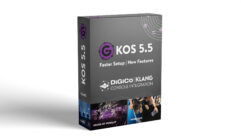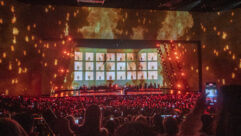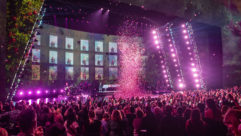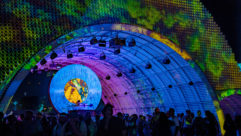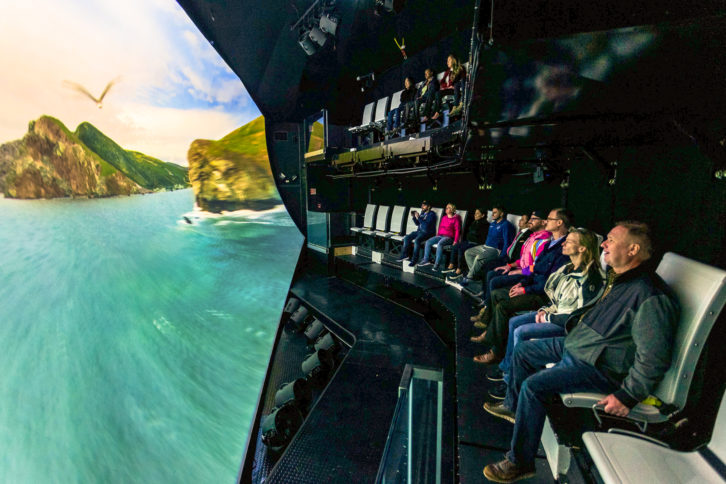
It’s well known that human experience is super-charged by audio. Pioneers in immersive audio have been working for decades to capture the holistic rush that comes with a complete audio experience; it’s been longer than that if you count the efforts of our pre-amplification ancestors who shaped literal rock and buildings to fill people’s minds and hearts with sound. Remarkable achievements have already come from work in immersive audio; that will accelerate in the coming decade, becoming the expected experience, even the norm. From there,…who knows? With that in mind, let’s look at a few recent experiences that are defined by immersive audio, with examples of playback, software, switches, studio environments, and even natural rock, all deployed in the service of audio immersion. –Cynthia Wisehart
Pier 39
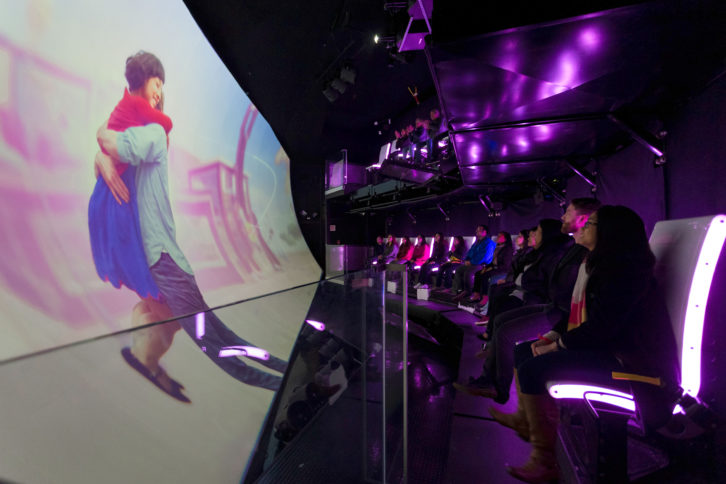
Pier 39 at Fisherman’s Wharf has seen its share of mid-budget projects that deliver the cutting-edge, theme park-style ride experience on a small scale. The latest is The Flyer, created by Québec-based Triotech. The virtual birds-eye footage of San Francisco is supported with a cinematic soundtrack.
Filmmakers captured the HD footage, with the help of drones and helicopters, and blended it with computer-generated imagery. The audio had to be equally immersive; the sweeping soundtrack is played back through a high-impact, high-fidelity sound system.
When The Flyer experience begins, 28 seated guests, suspended on an active-motion platform, embark on a high-definition “flight” through some of the Bay Area’s iconic landmarks and neighborhoods, including the Golden Gate Bridge, Alcatraz, Coit Tower, Marin Headlands, Chinatown, the Castro and more.
Mathieu Vachon, audio director for Triotech wrote, created, and produced the soundtrack and sound effects to follow the fast-paced point-of-view narrative that brings the city to life vividly with Hollywood-style jib, track, and drone-supported cameras. The sound had to be big.
To create the necessary playback impact, coaxial L-Acoustics X12 loudspeakers are positioned in an LCR array across the front of the attraction’s theater, behind its massive 1,100-square-foot (50›x22›) screen. Two rows of tiny 5XT speakers are mounted on the rear walls for the surround elements—one pair per side, covering and upper and lower seats—while four SB18 subwoofers complete the discrete 5.1 system, which is powered and processed by two LA4X amplified controllers. Montréal-based Solotech integrated the audio complement for Triotech in conjunction with L-Acoustics’s Andre Pichette, who performed the final system calibration via the manufacturer’s LA Network Manager software
“The soundtrack is extremely dynamic and exciting, and it also follows the emotions of the film very closely,” says Vachon, who adds that it took three months to envision, compose, record, and mix. “But once we were finally on-site at Pier 39 and I heard it played through the L-Acoustics sound system, I thought, ‘Wow!’ It was even better than in the studio. The score is huge and orchestral, and these loudspeakers make it feel so alive. The highs are crisp and clear, and the subs deliver a nice solid low end.”
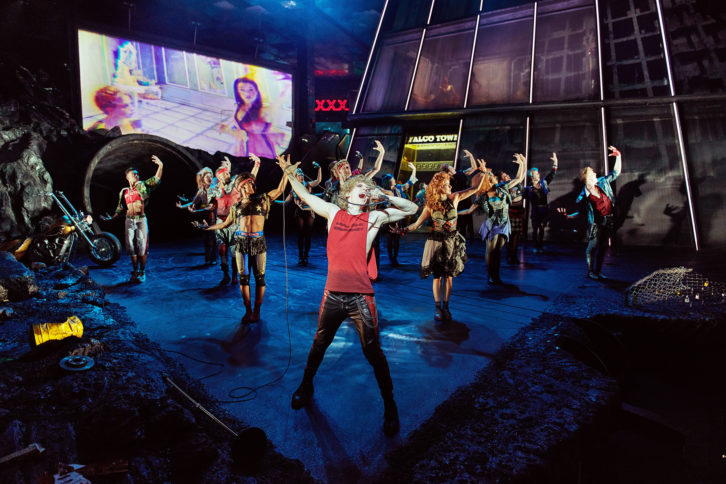 Something as small as a network switch can make a big difference when a designer is taking a chance on a new approach–and deploying it in situations that have to be rock-solid.
Something as small as a network switch can make a big difference when a designer is taking a chance on a new approach–and deploying it in situations that have to be rock-solid.
World class sound designer, Gareth Owen envisioned ground-breaking immersive sound designs for his all-new productions of the international hit musicals, Starlight Express, Bat Out of Hell, and Come From Away. But, the aesthetic innovation he pursued, would have to fit with a decidedly mainstream business model: Those shows must deliver night in, night out in an array of different theaters.
A seven-time Tony and Olivier winning and nominated sound designer, Gareth’s pioneering work can be heard all over the world, including Broadway, Las Vegas and London’s West End. Shows utilizing his designs have been enjoyed by over 30 million people. His latest collaborations—on Bat Out of Hell and Starlight Express in Germany, and Come From Away in London›s West End–set new standards in musical theatre, featuring uniquely immersive surround sound designs by the creative team at Gareth Owen Sound.
Utilizing d&b audiotechnik’s d&b Soundscape object-based sound design mixing platform, the technically demanding shows– which range from 180º up to full 360º implementation–feature a huge number of data channels running over Dante. With no analog backup for the audio systems, the network distribution has to be 100% reliable.
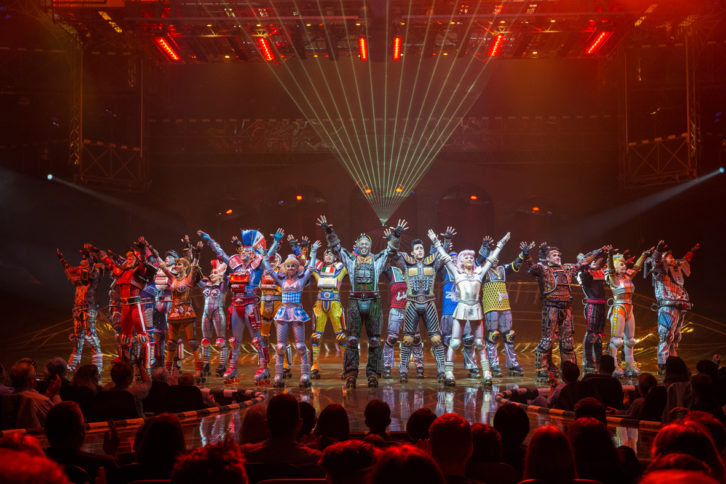 Working together with d&b and equipment suppliers to the shows–Stage Sound Services and Orbital Sound—the team depended on Luminex GigaCore network switches, which were rigorously tested in a Soundscape-based setup.
Working together with d&b and equipment suppliers to the shows–Stage Sound Services and Orbital Sound—the team depended on Luminex GigaCore network switches, which were rigorously tested in a Soundscape-based setup.
The team wanted a Dante-approved switch that was rock solid and road-worthy. “The Luminex switches have a proper case that’s not going to bend when they have to go up 16 stories and up onto fly floors, or when slammed off a truck,” Gareth points out.
The team also needed switches that were quick and easy to set up. “You don’t need a degree in IT to configure them,” Gareth adds. “You plug in, turn on, plug things into them, and they just work. Being able to fully isolate down what the network is seeing in terms of devices is extremely valuable.”
For complete peace of mind, all three shows utilize main and secondary Dante audio streams, which are run over entirely separate physical distribution networks.
“We run a dual-redundant Dante network utilizing the GigaCores, along with redundant PSUs that provide full power redundancy at each end of the wire for both sets of switches, so in the unlikely event of a failure, the system can seamlessly switch over to the redundant stream,” concludes Gareth who has standardized on Luminex switches for Dante distribution on all his shows. ”For such a show-critical piece of hardware, having such peace of mind is extremely important.”
The Luminex GigaCore switches were supplied to Stage Sound Services and Orbital Sound by the Audio sales division of exclusive UK distributor, A.C. Entertainment Technologies Ltd (AC-ET).
National Sawdust
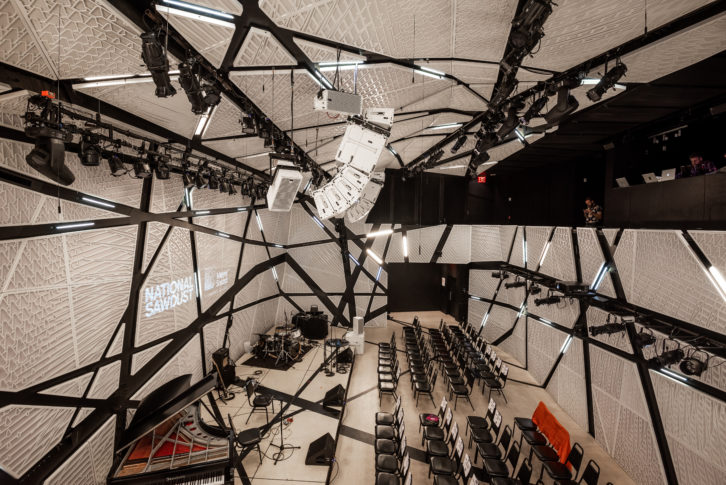
The experience of live immersive music is one of life’s pleasures. Technology is making it possible for small, unique venues to thrive and to take music forward in innovative and inclusive ways.
Since it launched in 2015, Brooklyn, New York’s National Sawdust has been praised as a world-leading incubator of new music talent as well as an intimate performance venue with excellent acoustics. Looking ahead to its fifth season, National Sawdust further elevated its reputation through a partnership with Meyer Sound, unveiling their new LINA direct reinforcement, Constellation active acoustics and Spacemap dynamic spatial audio mixing systems.
“With Constellation and Spacemap, National Sawdust now offers an almost unlimited palette for sonic creativity, experimentation and inspiration,” says renowned composer Paola Prestini, co-founder and artistic director of National Sawdust. “Immersive sound is profound for both performers and audiences, changing our sense of space and perception and making art more of an intimate and communal experience. National Sawdust is thrilled to partner with Meyer Sound as a lab for learning, discovery and innovation in performance.”
Playing a pivotal role in forging the new partnership was Garth MacAleavey, technical director and chief audio engineer for National Sawdust.
“The way our programming has evolved in the last few years has been very forward-thinking,” he notes, “and now that we have these modular acoustic and spatial audio tools readily at hand, it’s like having the controls of a spaceship to blast off into the future. We are looking at a revolution in how artists create their music and how patrons experience it.”
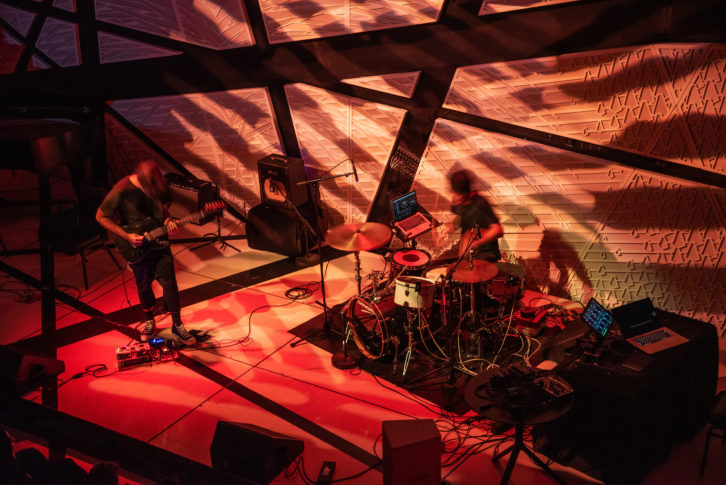
The Constellation system comprises 86 small, full-range loudspeakers plus 16 compact subwoofers for extending the reverberation envelope to the lowest bass frequencies. Sixteen miniature microphones provide ambient sensing, sending signals to a D-Mitri digital audio platform that includes a dedicated DVRAS module for providing the desired room acoustic. Although the room has an excellent, well-balanced physical acoustic, it is limited by the dimensions and materials of the space. With Constellation, the room’s baseline RT60 of 0.6s can be extended and reshaped as desired. Twelve presets are preprogrammed, ranging from “classroom” and “spoken word” to “large concert” and “cathedral.” Selected acoustic presets may be tailored to suit the aesthetic of each piece within a concert.
The Spacemap capability employs the same D-Mitri DSP platform and 102 loudspeakers to offer dynamic multichannel panning throughout the space, with 32 input channels freely assignable to any or all of the discretely addressable loudspeakers. Spacemap panning can be pre-programmed or implemented on the fly using an iPad interface.
“National Sawdust is the first venue where front of house engineers have been trained from the outset to fully integrate the live spatial mix capabilities of Constellation and Spacemap while working with such a wide range of musicians,” says Meyer Sound Director, Spatial Sound, Steve Ellison, “I’m excited to watch this extraordinary sonic journey unfold.”
Ellison highlights how the new Meyer Sound systems were employed during the opening concerts last year. “With vocalist Theo Bleckmann, we used the space as a lab to try out a few of his ideas. Using a longer reverberation, Theo was able to work with his own voice to create improvised harmonies during an acapella work. Then he added in microphones with signal processing, and together we experimented with moving the evolving vocal phrases out from the stage, into the audience and around the room,” he recalls. “Paola Prestini’s work, Silent Light, featured a small wood and marble tower with microphone pickup that was sent through a regenerating delay. We used Spacemap with both the original and delayed signals, incorporating a spiraling move on each sound but at different rates, so the sounds climbed up and down the walls, overlapping each other. For the Young People’s Chorus of New York City, who surrounded the audience, we extended the reverberation time to 2.4 seconds, which was very effective.”
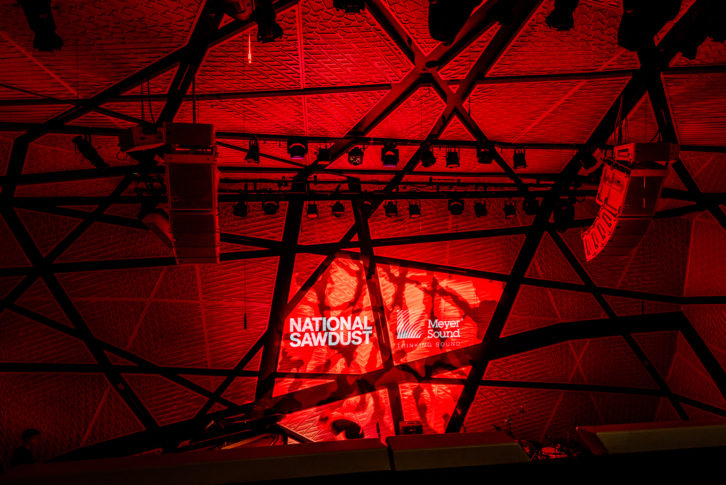
Even a musician’s body movements can be sonically transmuted, according to Ellison. “With Claire Chase, we used Spacemap with both the delay returns from her flute as well as her backing track. Her body movement informed the spatial mix of the flute delay, so it seemed she was ‘throwing’ her flute sound out into the room.”
National Sawdust retains the name of the industrial building it now occupies in Brooklyn’s Williamsburg district. Purchased by philanthropist Kevin Dolan, the structure was gutted and rebuilt following the design of Bureau V Architects. Global consulting firm Arup designed the original acoustics of the performance space, with a view towards future spatial audio system integration. These architectural acoustics and room finishes provided an excellent basis for Constellation and allowed for transparent integration of the system loudspeakers behind the room’s acoustically transparent fabric panels.
All audio systems were installed by Sound Associates of Yonkers, New York under the direction of Dominick Sack.
Blackbird Studio
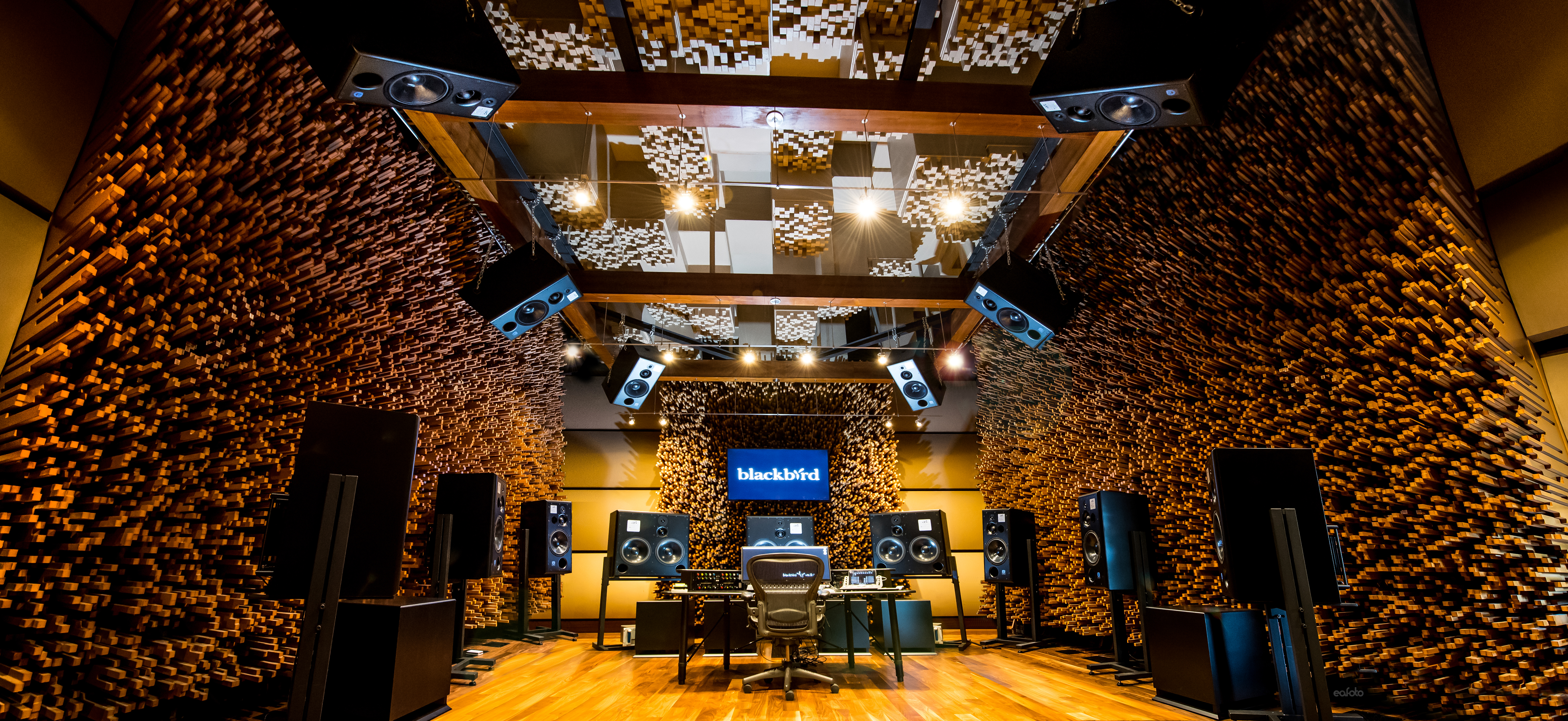 When it comes to pre-recorded immersive content, you have to build it somewhere before you can play it back. Gradually, there are more places rising up to serve that need, which will transform music and cinema and beyond.
When it comes to pre-recorded immersive content, you have to build it somewhere before you can play it back. Gradually, there are more places rising up to serve that need, which will transform music and cinema and beyond.
John McBride’s Blackbird Studio in Nashville, Tennessee is not known for half measures. “We do everything we can to create a setting where artists and engineers are equipped and inspired to create music that can change the world,” asserts McBride as Blackbird’s founder and spiritual leader.
In that spirit, Blackbird is embracing Dolby Atmos Music, a fully-immersive, next-generation multichannel playback system that has the backing of Universal, Netflix, Amazon, and other major content providers who are deploying immersive mixes in music, screened entertainment, and in theme park, museum, gaming and other virtual reality settings.
“Immersive audio is the future of the industry,” McBride continued. “It’s an incredible experience, and once you start listening in Dolby Atmos Music, it’s hard to go back to stereo! For artists and engineers, the format opens up a whole new world of creative possibilities. There are consumer electronics manufacturers building sound bars to give listeners Dolby Atmos in their living rooms, engineers are hard at work perfecting headphones that will deliver Dolby Atmos, content providers such as Netflix and Amazon are incorporating the format into their new material. Of course, the potential for gaming and virtual reality is astounding. All in all, the industry has a lot of momentum behind Dolby Atmos Music, and I’m thrilled to have Blackbird at the forefront of music creation for the format.”
Initially introduced in 2012, the Dolby Atmos specification accommodates traditional 7.1 surround sound speakers but then goes far beyond. It allows specific placement of sounds at precise locations along the sides and back, includes overhead loudspeakers, and permits flexible scaling of playback system size to include up to 128 discrete loudspeaker or subwoofer channels.
To support a commitment to immersive, Blackbird Studio C–a large control room with diffusion designed by George Massenburg- -now contains three ATC SCM300ASL Pro monitors in front, six ATC SCM100ASL Pro monitors on the sides, six ATC SCM100ASL Pro monitors on the ceiling, and six ATC SCM0.1/15ASL Pro subwoofers.
“The first thing people notice about a Dolby Atmos system is the addition of the overhead speakers,” said Zach Winterfeld, western regional sales manager with TransAudio Group and part of the team that installed and tuned the new system at Blackbird. “Just as the experience of going from mono to stereo or from stereo to surround opens things up, the overhead speakers add a whole new dimension. Under the hood, the biggest difference is the use of ‘objects’ that allow the engineer to specify where in the room a sound should localize to. The Dolby Atmos playback engine decodes each object’s location and places it there given the particular arrangement of loudspeakers in a given room. Two rooms can have very different loudspeaker setups, and the Dolby Atmos processing will localize a given ‘object’ to the same place in both rooms.”
Ben Lilly, technical sales manager with ATC and another member of the team that installed and tuned the new system at Blackbird, explains the setup, “Blackbird Studio C was already equipped with stereo ATC SCM300ASL Pros so adding a matching center was a natural choice. The ‘base’ specification for Dolby Atmos music systems is 7.1.4 (7.1 plus four overhead ‘top’ speakers), but because Studio C is larger than average, the surround speaker count was increased by four to make the system 9.1.6. The choice of surrounds speaker model and the number of subs was based on the room size, listening distance, and target SPLs at the listening position. Dolby’s DART tool helped select suitable monitors based on the room and acoustic data input into the tool.” Four of the ATC SCM0.1/15ASL subwoofers are positioned along the front of the room and two are positioned on the side walls closer to the back, as determined by a judicious combination of measurement and expert opinion.
In addition to Zach Winterfeld, who has deep experience with precision measurement systems, TransAudio Group sent Tony Marra, who operates the TransAudio Group in-house repair shop, to Nashville for installation and tuning knowing that between the two, they had the wherewithal to diagnose and repair anything that might need it. ATC sent Ben Lilly, who worked closely with the TransAudio Group team. The team dug into the analog processing capabilities of the integrated ATC amplifiers to make subtle adjustments to Blackbird’s existing SCM300ASL Pros, which had been in continuous use for nearly a decade, to match the new center channel SCM300ASL Pro. Ceri Thomas and Christine Thomas from Dolby saw to it that all of the Atmos specs were dialed in to perfection.
Aleks Bars, marketing manager at TransAudio Group, who attended the studio unveiling, added, “With conventional surround sound technology, things are still focused in the front, and creative use of the rear channels kind of stands out. With Dolby Atmos, I felt like I was inside the track. I couldn’t hear gaps between the speakers; it was really cohesive.”
“You get excited by different things and make different decisions when you’re mixing for stereo versus mono,” Winterfeld summarized. “The same thing is true moving to Dolby Atmos. Tracks have so much more room to exist and there are so many possibilities with movement, space, and location. It’s going to be exciting to hear what comes out of Blackbird Studio C!”
An Immersive Life
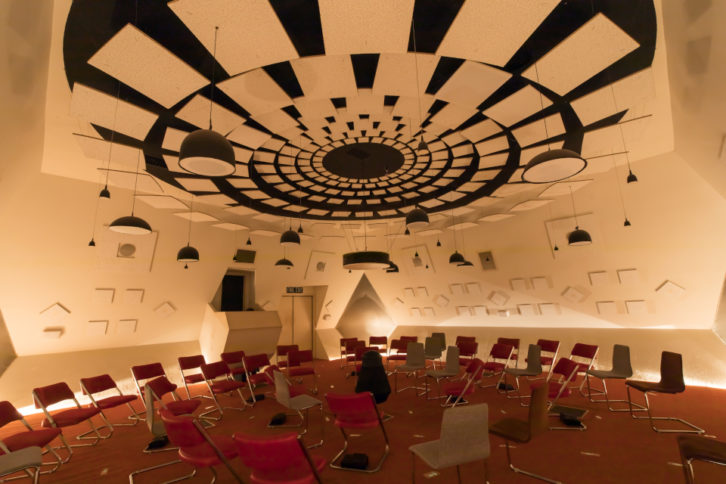 The Audium theater in San Francisco is one of the oldest continuous immersive audio experiences in the world, and the first theater of its kind to pioneer the exploration of space in music. Listeners are bathed in “sound sculptures” performed through 176 speakers—from car speakers to full-range line arrays—in total darkness.
The Audium theater in San Francisco is one of the oldest continuous immersive audio experiences in the world, and the first theater of its kind to pioneer the exploration of space in music. Listeners are bathed in “sound sculptures” performed through 176 speakers—from car speakers to full-range line arrays—in total darkness.
The Audium concept began in the 1950s, by trumpet player and electronic composer Stanley Shaff whose work with tape compositions and live performance convinced him that space was an inherent dimension of music. With his co-creator Doug McEachern who designed the original systems, the duo created their Audium platform for spatial, three-dimensional audio exploration. The partners worked together in the San Francisco Unified School District, and embarked on a series of collaborations and small performances—initially in Shaff’s home, with partners including students, light artists and dancer Anna Halprin. Through the 1960s, Audium saw performances at locations including San Francisco State, San Francisco Museum of Modern Art; the first Audium theater opened in 1967.
In 1975, Audium relocated to its current location on Bush Street. With a small grant from the National Endowment for the Arts the team designed and built the theater with a foyer, sound labyrinth, a performance space with sloping walls, floating floor and speakers hung above the audience and embedded in walls and floors, which are controlled live during the performances.
In the ensuing years, literally thousands of performances have graced and shaped the space. Audium also holds bi-monthly workshops to introduce participants to creating sound-sculptured space. In November, Stan and son David Shaff premiered Audium 11 after two years of development. It explores shifting sonic layers with a vast assortment of electronic sounds in Audium’s pitch-black theater. For this new work the father-son duo has completely reimagined the theater and artwork. Performances are held every Thursday, Friday & Saturday.
Acoustical Rock
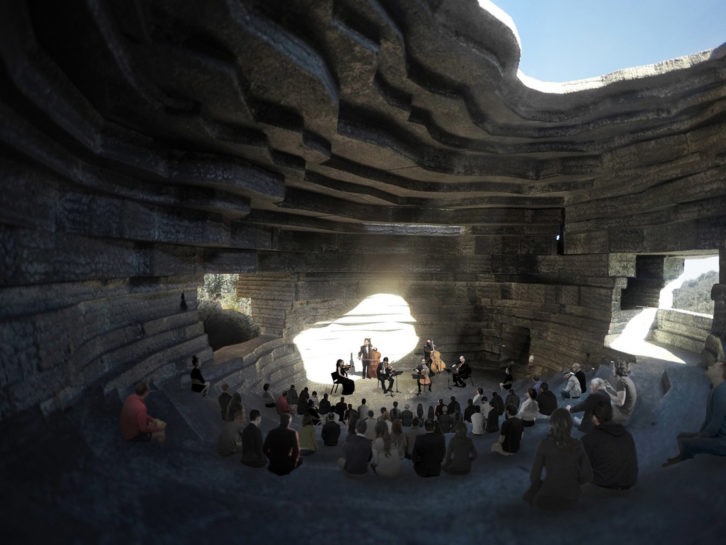 Acoustics can take many forms. The centuries-old power of rock still works. In November, Beijing-based architect OPEN poured the concrete for the roof of their spectacular Chapel of Sound. The boulder shaped concert hall sits in a rocky valley at the foot of Jinshanling Great Wall on Beijing’s northern border. The last pour of structural concrete for the flat roof took about 24 hours, with workers finishing the surfaces with handtools as they pushed to complete their work before the Beijing winter settles in. The building is slated to open in the summer of 2020.
Acoustics can take many forms. The centuries-old power of rock still works. In November, Beijing-based architect OPEN poured the concrete for the roof of their spectacular Chapel of Sound. The boulder shaped concert hall sits in a rocky valley at the foot of Jinshanling Great Wall on Beijing’s northern border. The last pour of structural concrete for the flat roof took about 24 hours, with workers finishing the surfaces with handtools as they pushed to complete their work before the Beijing winter settles in. The building is slated to open in the summer of 2020.
Inside the rocky outcropping is a semi-outdoor amphitheater, an outdoor stage, viewing platforms, and supporting spaces. The spectacular 790 square-meter semi-outdoor concert hall is made of concrete mixed with an aggregate of crushed local mineral-rich rocks, shaped acoustically for music performances. Openings in the roof and walls pull in the sky and surrounding landscape as well as the sounds of nature–light and rain, bird song, and the chirp of insects gently fill the chapel.
 The interior shape was inspired by the contours of shells, wooden instruments, and the human ear. Through digital optimization, the acoustic properties were tweaked to produce the best possible sound quality. The openings of the building are placed strategically to avoid unwanted reverberations while simultaneously allowing in natural sounds and views.
The interior shape was inspired by the contours of shells, wooden instruments, and the human ear. Through digital optimization, the acoustic properties were tweaked to produce the best possible sound quality. The openings of the building are placed strategically to avoid unwanted reverberations while simultaneously allowing in natural sounds and views.
The Chapel of Sound not only reimagines the typology of a concert venue, but asks us to reimagine the definition of a concert itself. “Inside this mysterious space, nature orchestrates an ever-changing symphony. It is a chapel of sound.”


